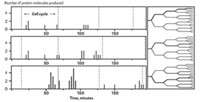Advertisement
Grab your lab coat. Let's get started
Welcome!
Welcome!
Create an account below to get 6 C&EN articles per month, receive newsletters and more - all free.
It seems this is your first time logging in online. Please enter the following information to continue.
As an ACS member you automatically get access to this site. All we need is few more details to create your reading experience.
Not you? Sign in with a different account.
Not you? Sign in with a different account.
ERROR 1
ERROR 1
ERROR 2
ERROR 2
ERROR 2
ERROR 2
ERROR 2
Password and Confirm password must match.
If you have an ACS member number, please enter it here so we can link this account to your membership. (optional)
ERROR 2
ACS values your privacy. By submitting your information, you are gaining access to C&EN and subscribing to our weekly newsletter. We use the information you provide to make your reading experience better, and we will never sell your data to third party members.
Analytical Chemistry
Giving DNA A Good Yank
Biophysics: Find adds fodder to question about nature of overextended DNA
by Carmen Drahl
January 24, 2011
| A version of this story appeared in
Volume 89, Issue 4

There’s more than one way to overstretch DNA, a new experiment suggests (J. Am. Chem. Soc., DOI: 10.1021/ja108952v). The finding recasts a 15-year-old debate on double-stranded DNA’s mechanical properties and might make it easier to calibrate instruments that measure small forces.
DNA experiences many forces during transcription and other biological events, but one particular force has become the subject of scientific fascination. “If you pull really hard on DNA, you think it’s about to break. But at 65 piconewtons of force, something amazing happens—it almost doubles in length,” says Thomas T. Perkins of JILA, a precision physics lab run jointly by the National Institute of Standards & Technology (NIST) and the University of Colorado, Boulder. A single piconewton is approximately the force exerted by the mass of 100 Escherichia coli bacteria, Perkins says.
What DNA looks like in that stretched-out, or “overstretched,” state is controversial, but several teams’ work suggests that nicks or breaks in the DNA always make the double-stranded molecule peel open to single-stranded DNA, Perkins says.
Perkins’ postdoctoral colleague, D. Hern Paik, tested that hypothesis with a piece of DNA containing no nicks or free ends and designed to freely rotate, an important characteristic for probing stretching in the desired force range. The pair’s results suggest that overstretched DNA can form in other ways than just peeling, Perkins says.
Researchers don’t know whether DNA experiences stretching forces of this magnitude in living things. But because the peculiar overstretching happens at a characteristic force, NIST is pursuing a piconewton-scale force standard based on DNA that could be used to calibrate instruments that measure all kinds of biological and chemical forces, Perkins says.
This study “may explain why it has been so difficult to unequivocally determine the structure of overstretched DNA,” says Mark C. Williams, a biophysicist at Northeastern University.




Join the conversation
Contact the reporter
Submit a Letter to the Editor for publication
Engage with us on Twitter